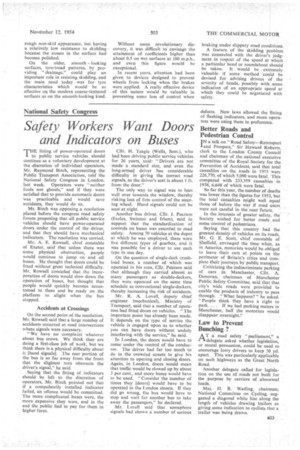Brakes and Skidding
Page 56

Page 57

If you've noticed an error in this article please click here to report it so we can fix it.
The Latest Findings
When new, or when the brakes were properly adjusted, the braking performance of the lightor medium-class commercial vehicle was similar to that of a new car, except that it was usually lower when the vehicle was fully laden.
This was one of the findings of Dr. H. J. H. Starks, and Mr. R. D. Lister, B.Sc.(Eng.), of the Road Research Laboratory, as given in a paper dealing with brake performance which they read to the Institution of IVIechanical Engineers (Automobile Division), in London, on Tuesday.
In a paper, " The Skid-resisting Properties of Road and Tyres," Mr. G. Grime, 0.B.E., MSc., and Mr. C. 0. Giles, B.Sc., reached the conclusion that ultimately, it was to the road engineer that one must look for safety from skidding in wet weather. Whatever the type of surface or materials employed, a harsh surface texture was the primary requirement to ensure a high resistance to skidding.
In a table presented by the authors, which had been compiled from The Commercial Motor road tests, it was shown that the mean braking distances of vehicles ranging from about 3 tons to about 20 tons, when laden, were almost the same, but that three heavy vehicles with trailers had a much longer braking distance than the others.
The table indicated that braking distances comparable to those of the best private cars could be obtained with some commercial vehicles haiiing gross laden weights of up to 20 tons. For others, however, the figures were nearly double.
Of used vehicles, the authors said that the post-1945 types had better brakes than the pre-1940 ones, and those with vacuum-assisted hydraulic brakes had a better performance than those with any other type of assisted brake. The mean braking distances of those used vehicles tested were much longer than those for vehicles which were new or which had properly adjusted brakes.
The results obtained showed that the braking performance of used vehicles suffered marked deterioration as compared with that attainable when the vehicles were new.
Buses Tested
Tests were made with six double-deck buses and two single-deckers. The unladen weight of the double-deckers was about 7/ tons, and that of the single-deckers about 61 tons. The respective laden weights when tested were approximately 9i tons and 8/ tons.
The types of brake represented were air pressure, triple servo vacuum and hydraulic with vacuum assistance. All the brakes had similar facing material and the same wheels and tyres were fitted to each bus in turn.
Little difference was observed in the mean braking distances from 30 m.p.h. The figures obtained were 72 ft. unladen and 84 ft. laden. The standard deviation was about 3.5 ft. in each case.
The corresponding average deceleration rates were 0.42g and 0.36g respectively. The maximum deceleration rates observed were 0.59g when unladen and 0.52g laden (standard deviation about 0.03g). The time taken to reach deceleration of 0.4g was about 0.5 sec.; the time delay in the braking system did not exceed 0.2 sec.
Experiments at the Laboratory had shown that deceleration of about 0.5g was liable to cause injury to seated passengers, and 0.25g might injure standing passengers. This was an important factor in designing brakes for passenger vehicles.
Tyre Patterns and Road Surfaces
THE old smooth-looking surfaces which used to prove dangerously slippery in wet weather, were fast disappearing, said Mr. Grime and Mr. Giles. Today the main concern was more with those coarse-textured surfaces with a
rough non-skid appearance, but having a relatively low resistance to skidding because the stones in the surface had become polished. .
On the older, smooth looking surfaces, tyre-tread patterns, by providing "drainage," could play an important role in resisting skidding, and the main need today was for tyre characteristics which would be as effective on the modern coarse-textured surfaces as on the smooth-looking kind.
Without some revolutionary discovery, it was difficult to envisage the attainment of coefficients higher than about 0.5 on wet surfaces at 100 m.p.h., and even this figure would be exceptional.
In recent years, attention had been given to devices designed to prevent wheels from locking when the brakes were applied. A really effective device of this nature would be valuable in preventing some loss of control when braking under slippery road conditions.
A feature of the skidding problem was connected with the driver's judgment in respect of the speed at which a particular bend or roundabout should be taken. It would be extremely valuable if some method could be devised for advising drivers of the severity of bends,. possibly with some indication of an approprjate speed at which they could be negotiated with safety.




































































































